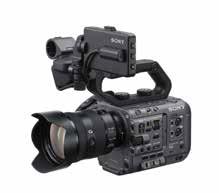
5 minute read
POWERING A CONNECTED FUTURE
HOW TO BRING THE CONNECTED ENTERPRISE TO LIFE AND MAKE SMARTER DECISIONS.
In this age of digitally-enabled business, organisations have to connect people, processes, and technologies seamlessly to deliver a better customer experience.
Advertisement
The connected enterprise strategy is essential to accelerate the digital transformation journey and create costeffective business processes.
What is a connected enterprise? How does it give your business a competitive edge? Finally, how do you build a connected enterprise?
“In today’s digital environment, every organisation is heavily investing in disruptive technologies such as IoT, AI, machine learning, analytics and various other automation technologies. Use of these technologies enable them to stay connected with every stakeholder— customers, employees, various line of businesses such as HR, IT, operations and finance, as well as various other physical and virtual environment,” says
Manish Ranjan, Program Manager for
Software & Cloud at IDC Middle East,
Turkey and Africa.
Connected enterprise implements
IoT, sensors, and various connected devices to collect various data, analyses them using advance analytics, AI and machine learning (ML) and gain greater business to improve its productivity and achieve greater customer experience. A connected enterprise is able to converge information technology (IT) and operation technology (OT) to streamline its operations, processes and optimise its resources, he says.
According to Vijay Jaswal, CTO, Middle East and Turkey, Software AG, a connected enterprise can be defined where people, data, and devices are connected in a manner that facilitates the enterprise to run at optimum operational efficiency levels and provide excellent customer service.
“Having said that, a truly connected enterprise is not the one that operates seamlessly within the system. An enterprise that integrates harmoniously not only within itself, but the connected ecosystem in totality is a truly connected enterprise,” he says.
A connected enterprise has data at its core and leverages that data to improve business processes, enhance productivity, cut operational expenditures and increase revenue and customer satisfaction.
“It can also use that data to enhance the work environment for improved employee well-being and output. Connected enterprises gain intelligence from data collected and turn that intelligence into meaningful actions in order to get ahead of the competition,” says Prem Rodrigues, director for the Middle East, Africa & India/SAARC at Siemon.
Building blocks
The Internet of Things (IoT) plays a fundamental role in building a connected enterprise as it facilitates the connection of billions of ‘datagenerating’ systems and devices. Gartner predicted that 50 billion devices will be connected to the IoT by 2020.
“A majority of these devices will be industrial equipment and machinery such as jet engines, vending machines, health monitoring systems, and other industry-specific devices. Therefore, it is imperative to calibrate enterprises around this impending reality,” says Jaswal from Software AG.
He adds the varied groups of people as a part of the ecosystem are most vital building blocks of any connected enterprise. These could range from customers, employees or partners to name a few. Different function responsibilities may involve
Manish Ranjan Vijay Jaswal Prem Rodrigues



information to be culled out from different applications and presented in a combined fashion. The ability of these different groups to access and present information in a swift and timely manner is vital in a digital playing field.
Rodrigues from Siemon comments that deploying the right IT infrastructure is key to building a connected enterprise. That infrastructure needs to enable network convergence, meaning that systems and devices no longer have to rely on disparate infrastructures but instead leverage a unified network that enables IP-based communication and the exchange of data.
He adds: “For organisations to gain the most from the data collected, IT infrastructures must allow for quick and efficient transmission of data for processing, analysing and storage. Effectively moving today’s larger sets of complex data requires high performance data centre infrastructures with reliable, low-latency, high bandwidth connections. At the same time these infrastructures must be scalable to accommodate the continued growth in data and bandwidth demand.”
Roadblocks
For a successful connected enterprise strategy, it is also important to align front and back-office functions to achieve better customer experience and identify areas that require attention.
“Connecting front and back office is the same as connecting people to data and data to data and and one enterprise to another enterprise., Governing the information is key and so is deadline management. If you use an automation tool to do that, an enterprise can get proactive warnings about when a process is about to breach a timeline that could affect the happiness of a customer,” says Jaswal.
Ranjan agrees that the integration of front office and back office is extremely important, especially to manage customer relationship more effectively. Customer touchpoints are always connected with front-office which generates a lot of critical data.
A lack of integration with back-office creates data-silos and organisations fail to utilise those critical data to address customers’ grievances/ feedbacks and struggle to gain a better customer experience and improve their productivity. Apart from this, a better integration improves the unified view of their customers, brings greater control over various processes across LoBs, enhances efficiency and automation and improves productivity, he says.
Even if you have all the core elements in place, creating a connected enterprise is easier said than done. In addition to complex processes, very few companies have the skills and resources to achieve the level of integration the connected enterprise warrants.
“Organisations must identify what business benefits they want to achieve while transforming themselves into a connected enterprise and then select the specific use case,” says Ranjan from IDC. “Evaluation of existing IT infrastructure also becomes critical as many organisations still run on legacy systems, which not only makes it difficult to integrate with various other systems but also creates departmental silos as well as data silos which also becomes a challenge. Lack of necessary data analytics skills is also a prominent challenge before organisations which aspire to become a connected enterprise.”
Rodrigues says there is a range of different challenges that companies might face, ranging from strategic ones for example identifying what exactly the business needs, all the way down to more technical challenges such as adopting the right infrastructure for data collection, ensuring compatibility and interoperability of different systems, having a common integration platform in place and the right skillset for data analytics. Data security and privacy issues will also have to be taken into account.
Jaswal says organisations shouldn’t boil the ocean to transform their business. “The big bang approach is common, and one that is not required; instead, a phased approach is what merits. The ideal is to look at key customer-facing processes and connections or the primary processes first, followed by the internal systems, the secondary and the tertiary systems etc.”










